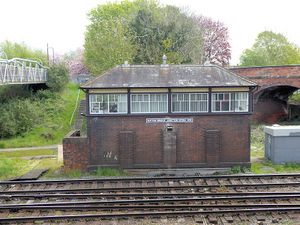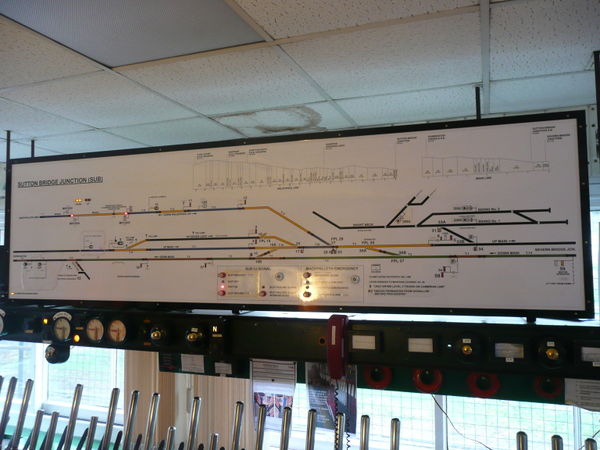Sutton Bridge Junction Signal Box
Sutton Bridge Junction Signal Box is an operational signal box on Network Rail. It is located approximately ¾ of a mile south of Shrewsbury station, and controls Sutton Bridge Junction. It originally controlled the connection between the Severn Valley Branch and the rest of the network at Shrewsbury, and still controls the junction between the Shrewsbury & Hereford line and the Cambrian line to Machynlleth, Aberystwyth and Pwllheli. It also controls access to Coleham Yard, and has an Up goods loop, which is the truncated 'Up Avoiding' goods only line which originally ran from Bayston Hill signal box to the south (now closed). The Up direction is towards Shrewsbury for the Cambrian and Hereford lines,[note 1] whilst Up was to the south on the Severn Valley line.
Contents
Construction and design
The present box was built in 1913 to replace earlier signalling installations at the junction, and is built to conventional GW style of the time all in brick. However, because of its location in connection with the Severn Valley line, it has full height windows on the operating floor around the whole northern end, an amendment to the standard design. Originally, it had nameplates mounted both front and rear facing the Shrewsbury & Hereford and Severn Valley lines respectively, but the rearmost one has at some point been removed and its whereabouts is unknown. In the main picture (right), the somewhat unusual choice of acronym of 'SUB' (for SUtton Bridge Junction) can be seen underneath the nameplate; the more logical 'SBJ' having been applied to the nearby Severn Bridge Junction.[1]
The Box has a standard GW design 61 lever 3-bar vertical tappet frame, original to the box from the date of construction. Three of the levers retain brass lever leads (the plate indicating the lever's purpose and what levers must be reversed to enable it to be worked), whilst the others all have the later rectangular 'Traffolyte' style.[note 2] Interestingly, the original lever leads related to the Severn Valley line referred to 'To' or 'From' Worcester, for example 'From Worcester Safety' for a lever which worked a trap point for any runaway train coming from Berrington.
Location
The box is built on the eastern side of the Shrewsbury & Hereford line (sometimes in conjunction with the Hereford and Newport referred to as the North & West). Originally the Severn Valley Branch came in from the southeast, passing behind the box to join the S&H line immediately north of it.
The box is situated just north of an angled road bridge which allows two roads to cross over the present and former railway lines. The junction and route by which the Severn Valley Branch passed under the road bridge can still be readily seen. Three lines ran behind the box, two forming the Severn Valley Branch itself and a third leading to the station's three road carriage shed. The Severn Valley Branch became single track at the far end of the carriage shed. Until 1988, a stub of the Severn Valley line remained in use, providing via a reverse move access to the site of Shrewsbury Abbey station (Shropshire & Montgomeryshire Light Railway), which remained in use as a fuel terminal. Today the route of the Branch south of the road bridge is now occupied by a housing estate.
The rear of the Box seen from the road bridge looking north. The concrete walking route roughly follows the line the SVR would have taken in its divergence from the main line. Shrewsbury station is approximately 2/3 of a mile northwards, to the left of this picture as the mainline takes a leftward curve.
In the 1960s the Shrewsbury & Hereford line came under the control of the London Midland Region (LMR) of British Railways as far south as Craven Arms, meaning the GWR design box and frame have since then undergone some notable changes. It now has standard BR bakelite block instruments, a LMR style block shelf - which bears LMR style lamp and arm indicators and the modern diagram - and electric lock releases actuated by catch handles on most electrically locked levers, rather than the GWR/BR(W) style block shelf plungers. Most of the test date stickers on the instruments and indicators date from 1966 suggesting the replacement of the shelf and equipment thereon occurred in 1966 or 1967.
The layout of the junction and access to Coleham Yard and other ancillary sidings and loops has over time been extensively remodelled since the late 1960s which has caused many levers to be taken out of or change use. This means for example that lever 5, which was originally the inner home signal reading off the Severn Valley line, is now the Up starting signal and therefore in continuous use.
The box was thoroughly measured in the 1980s by an SVR volunteer to ensure accuracy in the plans for Kidderminster Station signal box.
Current published plans indicate the box will be closed in 2025 with its area of control passed to Cardiff Rail Operating Centre (ROC), although it remains to be seen if this target will be achieved.
Signalling diagram
Signalling controlled from the box
As part of the significant remodelling of the layout at Sutton Bridge over time, many of the original GWR/BR(W) design signals have been replaced with standard BR(LMR) upper quadrant signals, unusually resulting in a GWR box controlling LMS style upper quadrant signals. The Up inner home on the Cambrian branch and the Down home bracket remain GWR/BR(W) lower quadrant design however. On the latter, the space can be made out for the signal that originally controlled the junction onto the Severn Valley line. The box also controls colour light signals in the form of its Up distant signals on both the Hereford and Cambrian lines, and the Up home on the Hereford line is a 3-position colour light, which only shows green when the Up inner home and starting signals are cleared. It will show a yellow when reversed, only once the home berth track circuit immediately in rear of it has occupied, effectively checking the train down to a low speed in accordance with what was (and still is on the SVR) Rule 39(a). The box's down distant signal, mounted beneath Severn Bridge Junction's starting signal, is one of only two remaining working lower quadrant distant signals on Network Rail.
The box works to Absolute Block regulations to the north and south, working to Severn Bridge Junction to the north and Dorrington to the south, and Marshbrook when Dorrington is switched out. It works to Machynlleth Signalling Centre under Track Circuit Block regulations as far as the commencement of Cab signalling board on the Cambrian, beyond which the in-cab signalling system European Rail Traffic Management System (ERTMS) comes into effect. Controls on communication between Sutton Bridge and Machynlleth are mounted on the diagram. Unusually for a box of its size, Sutton Bridge Junction has the capacity to switch out and does so on a daily basis, causing Severn Bridge to work to Dorrington or Marshbrook.
Originally the box worked to Coleham and Bayston Hill boxes to the north and south respectively, to Hookagate signal box towards Machynlleth, and to Burnt Mill Junction box on the Severn Valley Line, all by absolute block. All of those boxes have now closed, Burnt Mill in 1937 resulting in Electric Train Token working from Sutton Bridge to Berrington, Coleham and Bayston Hill boxes in the 1960s, and Hookagate in the 1980s when Electric Train Token was introduced between Sutton Bridge and Welshpool. This then gave way to Radio Electric Token Block on the Cambrian line, managed from Machynlleth Signal Box, which in turn gave way to the current ERTMS.








